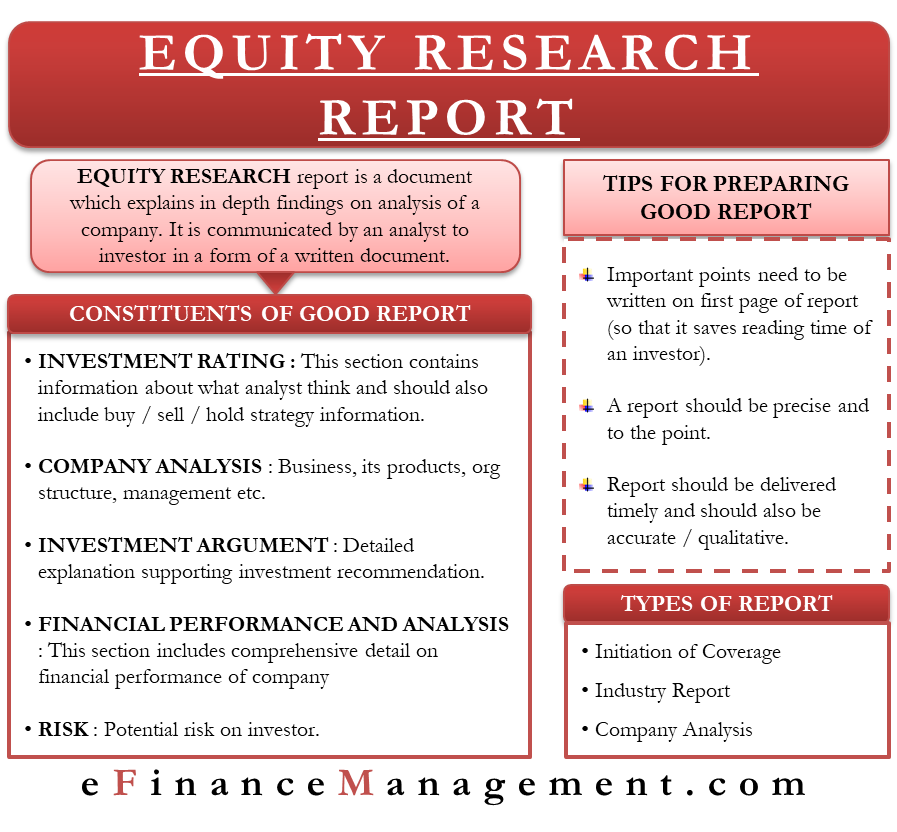What is an Equity Research Report?
An equity research report is a document prepared by an equity analyst. It is a form of communication between financial experts and investors. The analyst conducts an in-depth analysis of a company, industry, or even an economy and explains his findings in the form of a report. The purpose of preparing such reports is to provide investment recommendations to the clients (buy, sell or hold).
Who Produces Them?
As we are all aware, Buy-side firms conduct their own research on which stocks they should buy and sell. The reports are only used internally by their portfolio managers and are not available publicly.
Sell-side firms conduct equity research on behalf of their clients. Investment banks or brokerage houses sell their investment ideas to clients, expecting transaction costs and commissions in return (though there is no rule that clients have to buy). Hence, they produce reports to help them make better investment decisions. These reports are often available free for their clients. Examples of clients for such reports are pension funds, insurance companies, retail and institutional investors, etc.
Constituents of an Equity Research Report
Let us take a sneak peek into an equity research report and understand what sections are required in the report. Most of the equity reports have the following in the list of sections.
Also Read: Equity Research
Investment Rating / Recommendation
This section gives an idea of what the analyst thinks about the stock. It is usually either buy, sell, or hold. This section also includes a target price, which means the best price (as per the analysts’ view) to buy/sell a company.
Company Analysis
Includes information regarding the company. This section covers the company’s business, its products, organizational structure, management, etc. It also consists of any recent information released by the company like major contracts, management changes, or any other important information about the company.
Investment Argument
Here, the analyst provides a detailed explanation supporting his investment recommendation. This is the most important section of the report, and an analyst spends most of his time drafting this part.
Financial Performance and Analysis
Financial analysis is performed in excel using financial modeling, but its findings are presented here. This section provides comprehensive detail on a company’s financial performance, its historical performance, and current earnings. The analyst also presents the valuation of the company and his assumptions used to predict future earnings.
Also Read: Equity Research Analyst
Risk
This section addresses the potential risks an industry or a company poses to an investor. For instance, regulatory risks, operational risks, financial risks, etc., can significantly impact the stock price.

Sample Report
Following is a sample report published by one of the major financial centers.

Types of Equity Research Reports
Following are the three main categories of these reports:
Initiation of Coverage
When a broker or an analyst starts covering up the stock for the first time, he publishes this report. This means this is the first time an analyst gives a recommendation on a particular company. Therefore, this is a detailed report that explains many things about the company. For example, the report provides exhaustive information on the company’s business, its products, services, industry, and market data. It also provides other details, for example, the rationale behind the investment recommendation, valuation, information on competitors, etc.
Industry Report
This report provides deep insights into a particular industry. For example, the report covers topics like recent trends in the industry, updates on the recent regulations, competitors, etc. This type of report is also usually long because it covers an entire industry. An industry report also covers information on key drivers, risk factors, and overall valuation levels, followed by shorter sections on specific companies.
Company Analysis
This report is a relatively shorter one. Analyst issues this report to update the existing ones that already have an investment recommendation. This covers events happening in the company. For instance, earnings releases, investor day, or any major announcements by the company affect its strategies, such as an acquisition or a new product launch.
Tips for Preparing Good Reports
- An investor often would not have enough time to read the complete report. Hence, all the important items like a recommendation, target price, and earnings estimates must be present on the first page.
- Too much information is poisonous. A good report is that when a reader gets the required insight for the first time, he reads it. Therefore, the report has to be precise and right to the point.
- Quality and quantity matter. It is necessary to provide accurate information and is also important to deliver the reports on time. Many brokerage firms come up with similar reports. Hence, our report gains significance only if it is the first in the market to report any updates on a particular company. For example, an earnings release update does not make sense after 3 to 4 days after the release.


Thank You For Sharing